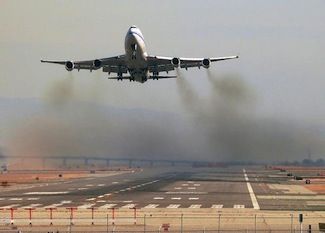Green on the Go: Air Travel and Climate Change
The airplane has opened up the entire planet for us; air travel allows us to visit virtually anyone, anywhere on the planet in just a mere few hours. But the ability to travel quickly to far-off lands comes at a cost, environmentally. Here we will examine how global air travel affects climate change.How Does Air Travel Impact Climate Change?
The fact rarely gets the attention it deserves, but air travel is the biggest single contributor to climate change within the transportation sector. Traveling by air accounts for roughly 10% of all carbon emissions within the U.S., compared to 36% for automobiles.
A small portion of that air travel is freight transport, but the bulk of flights and the weight they carry appears to be traveller travel, not freight. And though many automobile trips are unavoidable in our day-to-day lives, many of the air flights are unnecessary .
Air travel excels at getting us places quickly, but it also excels at pumping massive amounts of carbon dioxide and other air pollutants into the air, and doing so at high altitudes where they do the most damage. One round-trip flight from New York to Europe or New York to San Francisco adds about2 or 3 tons of carbon dioxide per person. Since the average American generates about 19 tons of carbon dioxide per year,and the average European 10, it's easy to see how just a few airplane trips a year can add significantly to an individual's carbon footprint .
Air travel emissions currently account for only about 5 percent of climate changing emissions, that percentage is expected to rise dramatically, since the volume of air travel is increasing much faster than improvements in new planes' fuel efficiency. Many airlines today acknowledge their industry's affect on climate change and have tried to reduce their carbon footprints through technical innovations such as more efficient aircraft designs and the use of renewable biofuels. Unfortunately they have so far successfully resisted any regulation or increased taxation of their emissions. The obvious way to reduce the climate changing impact of air travel is to take fewer flights. But in a free society, we cannot place unreasonable restrictions on an individuals' personal rights; we also don't want to take away anybody's ability to see in person the beauty of different parts of the world, or to see far-flung loved ones. Banning air travel outright simply isn't an option, but there are ways to reduce its impact. (And yes, reducing the number of flights taken by individuals, preferably to zero, is the best option.)Ways to Reduce Environmental Impact of Air Travel
If you are unable or unwilling to eliminate air travel from your life (and there can be no judging of anyone who does fly as our lives are all different,) there are some ways to cut the impacts.
- Take Direct Flights Whenever Possible:Takeoffs and landings consume much more fuel than high-altitude cruising. Direct flights minimize these, and are just more all-around convenient as well.
- Research Airlines that Fly Newer Planes:Newer planes have much more fuel-efficient engines than aging models, and are lighter and more aerodynamic as well, further increasing their mileage.
- Pack Lightly: On any airplane, weight matters. The more weight a plane has to haul, the more fuel it needs.
- Fly During the Day: Airplane contrails (the white lines of exhaust streaming behind planes) are major sources of climate changing gasses. During the daytime, some of their climate changing qualities are offset by reflecting sunlight away from the earth.
- Fly Business Class or Coach: The more passengers a plane carries, the less fuel per passenger is required. It won't, however, do a thing for your own personal comfort on a crowded plane.
- "Travel" Through Cyberspace: Many flights are taken for business purposes. New advances in communications technology make it possible to hold high-quality 'face-to-face' meetings with clients on the other side of the country or world via the internet. This can reduce the frequency of business trips, which not only reduces pollution but also saves the company time and money as well.
- Buy Carbon Offset Credits: Available through several companies, a carbon offset is a form of credit. By calculating the distance traveled, and the mode of transportation (car, plane, train, etc.) these companies estimate how much carbon-causing pollution your trip will create. The money from the purchased carbon offset credits is used to support and create large-scale renewable energy projects (such as wind farms) that reduce an amount of pollution equal to the amount created by your trip. It's a bit abstract, but if a trip by plane (or any other mode of transportation) is unavoidable, they are a helpful way to reduce its environmental impact.
Return to the Green on the Go main page!
comments powered by Disqus



























































































































































































